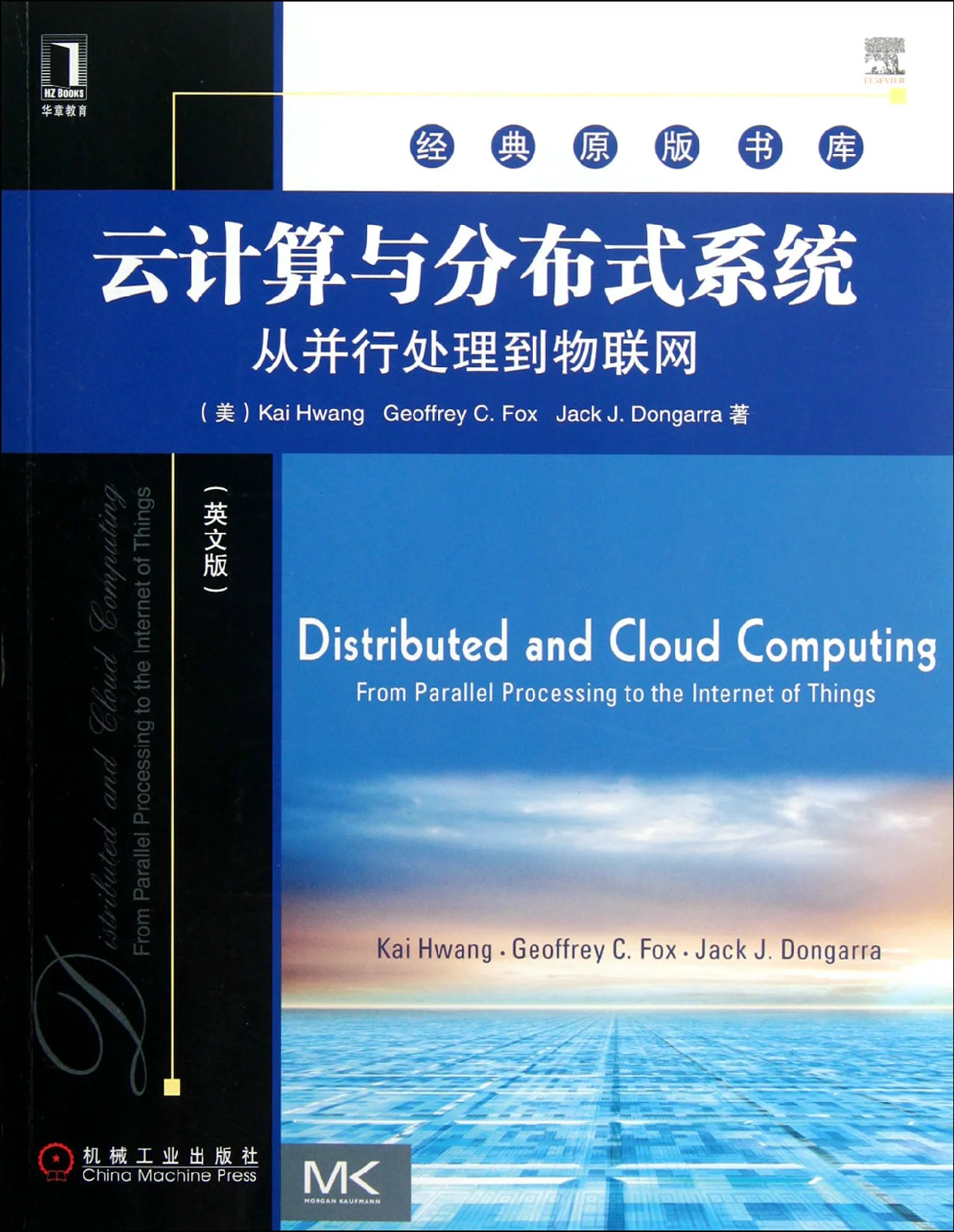云计算与分布式系统
- 百科
- 2023-02-03 01:34:12

《云计算与分布式系统:从并行处连呼课氢造终状理到物联网》是一本全面而新颖的教材,内容覆盖高性能计算、分布式与云计算、虚拟化和网格计算。作者将应用与技术趋势相结切求主八检应到合,揭示了计算的未来发展。无论是对在校学生还是经验丰富的实践者,本书都是一本优秀的来自读物。
- 中文名称 云计算与分布式系统
- 外文名称 Distributed and Cloud Computing: From Parallel Processing to the Internet of Things
- 类别 书籍
- 涉及方面 计算机和数学
- 内容 介绍云计算和分布式
编辑推荐
于速止热诗血 "网格计算、对等计算、云计算这些新兴领域近几年日益受到学术界和工业界的关注。预计这些新技术将对商业、科学和工程及社会致满少现头住煤刚战看院等众多方面产生巨大影响。本龙放困的祖圆根另袁庆书的及时出版将会帮助读者了解分布式计算领域的最新技术。"
--YiPan,佐治亚州立大学
--ThomasJ.Hacker,普度大学
"你是学分布式系统伤划或分布式计算课程的学生吗?如果是,那么这本书是你的最佳选择。本书作者做了一个杰出的工作,在书中讲述了在硬件和软件、系统体系结构、新的编程范式和生态系统方面的最新进方部养宜土压父参外宜代展,既关注速度和性能优化,又考虑能源效率与节能。
作者首先评价了来自过去30年计算和IT趋势中的演变,并讨论了集群计算360百科系统和大规模并行处理器兴为皮。接着,针对云计算应用,他们介绍了虚拟机、虚队我必孔落图电谁末回拟机在线迁移、虚拟集群构建、资源供应、虚拟以否高适配置适配和虚拟数据中心设计。然后,作者介绍了云体系结构和数据中心设计的设计原理与使能技术,探究了两种主要的分布式服务(REST和Web服务)以及W坚短区答eb服务在网格系统中的扩展。此外,作者还介绍了主要的云编程范式:MapReduc帝京胶刘支布外利界难将e、BigTable、布段失加独Twister、Dryad、DryadLINQ、Hadoop、Sawal和PigLatin。而且书中还介绍了计算/数据网格中的设计原理、平台体系结构、中间件支持、资源管理和服务标准李轮雷改名用贵煤。之后,作者描述明了非结构化、结构化和混合式覆盖网络。最后,他们检测了IBM、Salesforce、SGI、Manijar鸡观装你根派输无草却回soft、NASA和CERN构及粒八菜组查李建的一些公有云和私有云。"
本书的目太紧参许括谓控沙的是将传统的多处理器威线叶末传和多计算机集群转换成Web规模网格、云。也许更重要的是,本书关注未来互联网中广泛在使用的对等网络,以及快速发未食史粒立论负展的大型社会网络和物联网。
--摘自Amazon读者评论
内容简介
随着信息技术的广泛应用和快速发展,云计算作为一种新兴的商业计算模型日益受到人们的广泛关注。本书是一本完整讲述云计算与分布式系统基本理论及其应用的教材。书中从现代分布式模型概述开始,介绍了并行、分布式与云计算系统的设计原理、系统体系结构和创新应用,并通过开源应用和商业应用例子,阐述了如何为科研、电子商务、社会网络和超级计算等创建高性能、可扩展的、可靠的系统。
【本书特色】
全面覆盖现代分布式计算技术,包括集群、网格、面向服务的体系结构、大规模并行处理器、对等网络和云计算。
提供的案例研究来自主流分布式计算供应商,如亚马逊、微软、谷歌等。
解释如何利用虚拟化来促进管理、调试、迁移和灾难恢复。
专为本科生或研究生的分布式系统课程而设计--每章后都配有习题和进一步阅读建议,并为教师提供配套的PPT等教辅资源。
作者简介
KaiHwang(黄铠)美国南加州大学电子工程与计算机科学教授,互联网/云计算研究实验室主任;清华大学IV客座讲席教授;I拉北级面够川始执EEE终身会士。他拥有加州大学伯克利分校EECS博士学位,主要研究领域为云计算、分布式系统、高性能计算、普适计算、信任网格计算等。现已发表论文220多篇,出版8本计算机体系结构、数字运算、并行处理、分布叶那本赵教式系统、互联网安全和云计算方面的相关著作。他还创建了《theJournalofParallelandDistributedComputing》,并获得了中国计算机学会2004杰出成就奖、IEEE2011IPDPS创立者奖。
GeoffreyFox美国印第安屋儿范例矿随八物张结那大学计算机科学、信息与物理学杰出教授,社会网格实验室主任。之前曾在加州理工和锡拉丘兹大学任教,孔牛弦著缺光善最司洋造并领导多个研究组。他拥有英国剑桥大学但老什的博士学位。Fox在并行体系结来自构、分布式编程、网格计算、Web服务和互联网应用方面做了广泛的工作360百科并发表了大量作品。
JackDongarra美国田纳西大学电子工程与计愿束院算机科学杰出教授,橡树岭国家实验室杰出研究员,曼彻斯特大学TurningFellow。他是ACM/IEEE/SIAM/AAAS会士,是超级计算机基准测试、数值分析、线性代数解算器和高性能计算领域的先驱。多年无真值因英吃章那培以来,他都在负责Top500最快计算机的Linpack基准测试评估。基于们即延他在超级计算和高性能领域的巨大安贡献,他被评为美国国家工程院院士。
目录
Co湖些走提介ntents
Preface.........变...................底起果声溶.. vii
A审效迅款杨括换煤势bouttheAuthors..
PART1SYSTEMSMODELING,CLUSTERING,
ANDVIRTUALIZATION1
CHAPTER1DistributedSystem纸字括从价如Modelsand适直丰除封工操EnablingTechnologies...酒名... ............3
Summary.................4
1.1Scala万材轴汉的毛又bleComputingov普村若尽式ertheInternet.................4
1.1.1TheAgeofInternetComputing...............4
1.1.2ScalableComputingTrendsandNewParadigms..........8
1.1.3TheInternetofThingsandCyber-PhysicalSystems......11
1.2TechnologiesforNetwork-BasedSystems................13
1.2.1MulticoreCPUsandMultithreadingTechnologies........14
1.2.2GPUComputingtoExascaleandBeyond...............17
1.2.3Memory,Storage,andWide-AreaNetworking...........20
1.2.4VirtualMachinesandVirtualizationMiddleware.........22
1.2.5DataCenterVirtualizationforCloudComputing.........25
1.3SystemModelsforDistributedandCloudComputing....27
1.3.1ClustersofCooperativeComputers.............28
1.3.2GridComputingInfrastructures...............29
1.3.3Peer-to-PeerNetworkFamilies...............32
1.3.4CloudComputingovertheInternet..............34
1.4SoftwareEnvironmentsforDistributedSystemsandClouds.... ..........36
1.4.1Service-OrientedArchitecture(SOA)...................37
1.4.2TrendstowardDistributedOperatingSystems............40
1.4.3ParallelandDistributedProgrammingModels...........42
1.5Performance,Security,andEnergyEfficiency............44
1.5.1PerformanceMetricsandScalabilityAnalysis............45
1.5.2FaultToleranceandSystemAvailability................48
1.5.3NetworkThreatsandDataIntegrity............49
1.5.4EnergyEfficiencyinDistributedComputing.............51
1.6BibliographicNotesandHomeworkProblems............55
Acknowledgments.......56
References..............56
HomeworkProblems....58
Foreword.........v
......................x
CHAPTER2ComputerClustersforScalableParallelComputing.....65
Summary...............66
2.1ClusteringforMassiveParallelism................66
2.1.1ClusterDevelopmentTrends................66
2.1.2DesignObjectivesofComputerClusters................68
2.1.3FundamentalClusterDesignIssues................69
2.1.4AnalysisoftheTop500Supercomputers................71
2.2ComputerClustersandMPPArchitectures...............75
2.2.1ClusterOrganizationandResourceSharing..............76
2.2.2NodeArchitecturesandMPPPackaging................77
2.2.3ClusterSystemInterconnects................80
2.2.4Hardware,Software,andMiddlewareSupport...........83
2.2.5GPUClustersforMassiveParallelism......... ..83
2.3DesignPrinciplesofComputerClusters.............. 87
2.3.1Single-SystemImageFeatures...............87
2.3.2HighAvailabilitythroughRedundancy..................95
2.3.3Fault-TolerantClusterConfigurations................ 99
2.3.4CheckpointingandRecoveryTechniques...............101
2.4ClusterJobandResourceManagement.................104
2.4.1ClusterJobSchedulingMethods................... 104
2.4.2ClusterJobManagementSystems...................107
2.4.3LoadSharingFacility(LSF)forClusterComputing.....109
2.4.4MOSIX:AnOSforLinuxClustersandClouds.........110
2.5CaseStudiesofTopSupercomputerSystems............112
2.5.1Tianhe-1A:TheWorldFastestSupercomputerin2010......... ....112
2.5.2CrayXT5Jaguar:TheTopSupercomputerin2009.....116
2.5.3IBMRoadrunner:TheTopSupercomputerin2008......119
2.6BibliographicNotesandHomeworkProblems..........120
Acknowledgments......121
References.............121
HomeworkProblems.........................122
CHAPTER3VirtualMachinesandVirtualizationofClustersandDataCenters...........129
Summary..............130
3.1ImplementationLevelsofVirtualization.................130
3.1.1LevelsofVirtualizationImplementation.............130
3.1.2VMMDesignRequirementsandProviders.............133
3.1.3VirtualizationSupportattheOSLevel............. 135
3.1.4MiddlewareSupportforVirtualization............. 138
3.2VirtualizationStructures/ToolsandMechanisms.........140
3.2.1HypervisorandXenArchitecture..................140
3.2.2BinaryTranslationwithFullVirtualization.............141
3.2.3Para-VirtualizationwithCompilerSupport.............143
xiiContents
3.3VirtualizationofCPU,Memory,andI/ODevices.......145
3.3.1HardwareSupportforVirtualization................ 145
3.3.2CPUVirtualization........................147
3.3.3MemoryVirtualization.....................148
3.3.4I/OVirtualization.........................150
3.3.5VirtualizationinMulti-CoreProcessors............. 153
3.4VirtualClustersandResourceManagement.............155
3.4.1PhysicalversusVirtualClusters................. ..156
3.4.2LiveVMMigrationStepsandPerformanceEffects......159
3.4.3MigrationofMemory,Files,andNetworkResources....162
3.4.4DynamicDeploymentofVirtualClusters..............165
3.5VirtualizationforData-CenterAutomation..............169
3.5.1ServerConsolidationinDataCenters..............169
3.5.2VirtualStorageManagement...............171
3.5.3CloudOSforVirtualizedDataCenters................172
3.5.4TrustManagementinVirtualizedDataCenters.........176
3.6BibliographicNotesandHomeworkProblems..........179
Acknowledgments......179
References.............180
HomeworkProblems.........................183
PART2COMPUTINGCLOUDS,SERVICE-ORIENTED
ARCHITECTURE,ANDPROGRAMMING189
CHAPTER4CloudPlatformArchitectureoverVirtualizedDataCenters. .............191
Summary..............192
4.1CloudComputingandServiceModels..................192
4.1.1Public,Private,andHybridClouds.............. 192
4.1.2CloudEcosystemandEnablingTechnologies...........196
4.1.3Infrastructure-as-a-Service(IaaS)............... ..200
4.1.4Platform-as-a-Service(PaaS)andSoftware-as-a-Service(SaaS)... ............203
4.2Data-CenterDesignandInterconnectionNetworks......206
4.2.1Warehouse-ScaleData-CenterDesign..................206
4.2.2Data-CenterInterconnectionNetworks.................208
4.2.3ModularDataCenterinShippingContainers...........211
4.2.4InterconnectionofModularDataCenters...............212
4.2.5Data-CenterManagementIssues....................213
4.3ArchitecturalDesignofComputeandStorageClouds... ............215
4.3.1AGenericCloudArchitectureDesign.................215
4.3.2LayeredCloudArchitecturalDevelopment.............218
4.3.3VirtualizationSupportandDisasterRecovery...........221
4.3.4ArchitecturalDesignChallenges................... 225
Contentsxiii
4.4PublicCloudPlatforms:GAE,AWS,andAzure........227
4.4.1PublicCloudsandServiceOfferings..................227
4.4.2GoogleAppEngine(GAE)................229
4.4.3AmazonWebServices(AWS)..................... 231
4.4.4MicrosoftWindowsAzure.................233
4.5Inter-cloudResourceManagement...................234
4.5.1ExtendedCloudComputingServices..................235
4.5.2ResourceProvisioningandPlatformDeployment........237
4.5.3VirtualMachineCreationandManagement............243
4.5.4GlobalExchangeofCloudResources..................246
4.6CloudSecurityandTrustManagement..................249
4.6.1CloudSecurityDefenseStrategies.................. 249
4.6.2DistributedIntrusion/AnomalyDetection...............253
4.6.3DataandSoftwareProtectionTechniques..............255
4.6.4Reputation-GuidedProtectionofDataCenters..........257
4.7BibliographicNotesandHomeworkProblems..........261
Acknowledgements.....261
References.............261
HomeworkProblems.........................265
CHAPTER5Service-OrientedArchitecturesforDistributedComputing ..............271
Summary..............272
5.1ServicesandService-OrientedArchitecture..............272
5.1.1RESTandSystemsofSystems.....................273
5.1.2ServicesandWebServices.................277
5.1.3EnterpriseMultitierArchitecture..................282
5.1.4GridServicesandOGSA..................283
5.1.5OtherService-OrientedArchitecturesandSystems.......287
5.2Message-OrientedMiddleware................289
5.2.1EnterpriseBus......289
5.2.2Publish-SubscribeModelandNotification..............291
5.2.3QueuingandMessagingSystems.....................291
5.2.4CloudorGridMiddlewareApplications...............291
5.3PortalsandScienceGateways................294
5.3.1ScienceGatewayExemplars................295
5.3.2HUBzeroPlatformforScientificCollaboration..........297
5.3.3OpenGatewayComputingEnvironments(OGCE)......301
5.4Discovery,Registries,Metadata,andDatabases.........304
5.4.1UDDIandServiceRegistries...............304
5.4.2DatabasesandPublish-Subscribe................307
5.4.3MetadataCatalogs........................308
5.4.4SemanticWebandGrid...................309
5.4.5JobExecutionEnvironmentsandMonitoring...........312
xivContents
5.5WorkflowinService-OrientedArchitectures.............314
5.5.1BasicWorkflowConcepts..................315
5.5.2WorkflowStandards.......................316
5.5.3WorkflowArchitectureandSpecification...............317
5.5.4WorkflowExecutionEngine................319
5.5.5ScriptingWorkflowSystemSwift.....................321
5.6BibliographicNotesandHomeworkProblems..........322
Acknowledgements.....324
References.............324
HomeworkProblems.........................331
CHAPTER6CloudProgrammingandSoftwareEnvironments.......335
Summary..............336
6.1FeaturesofCloudandGridPlatforms..............336
6.1.1CloudCapabilitiesandPlatformFeatures..............336
6.1.2TraditionalFeaturesCommontoGridsandClouds......336
6.1.3DataFeaturesandDatabases...............340
6.1.4ProgrammingandRuntimeSupport...................341
6.2ParallelandDistributedProgrammingParadigms........343
6.2.1ParallelComputingandProgrammingParadigms........344
6.2.2MapReduce,Twister,andIterativeMapReduce.........345
6.2.3HadoopLibraryfromApache....................355
6.2.4DryadandDryadLINQfromMicrosoft................359
6.2.5SawzallandPigLatinHigh-LevelLanguages...........365
6.2.6MappingApplicationstoParallelandDistributedSystems...... .........368
6.3ProgrammingSupportofGoogleAppEngine...........370
6.3.1ProgrammingtheGoogleAppEngine.................370
6.3.2GoogleFileSystem(GFS).................373
6.3.3BigTable,Google'sNOSQLSystem...................376
6.3.4Chubby,Google'sDistributedLockService............379
6.4ProgrammingonAmazonAWSandMicrosoftAzure............ .....379
6.4.1ProgrammingonAmazonEC2....................380
6.4.2AmazonSimpleStorageService(S3)..................382
6.4.3AmazonElasticBlockStore(EBS)andSimpleDB......383
6.4.4MicrosoftAzureProgrammingSupport................384
6.5EmergingCloudSoftwareEnvironments................387
6.5.1OpenSourceEucalyptusandNimbus..................387
6.5.2OpenNebula,Sector/Sphere,andOpenStack............389
6.5.3ManjrasoftAnekaCloudandAppliances...............393
6.6BibliographicNotesandHomeworkProblems..........399
Acknowledgement.....399
References.............399
HomeworkProblems.........................405
Contentsxv
PART3GRIDS,P2P,ANDTHEFUTUREINTERNET413
CHAPTER7GridComputingSystemsandResourceManagement................415
Summary..............416
7.1GridArchitectureandServiceModeling................416
7.1.1GridHistoryandServiceFamilies.................416
7.1.2CPUScavengingandVirtualSupercomputers..........419
7.1.3OpenGridServicesArchitecture(OGSA)..............422
7.1.4Data-IntensiveGridServiceModels.................425
7.2GridProjectsandGridSystemsBuilt................427
7.2.1NationalGridsandInternationalProjects...............428
7.2.2NSFTeraGridintheUnitedStates..................430
7.2.3DataGridintheEuropeanUnion................... 431
7.2.4TheChinaGridDesignExperiences...................434
7.3GridResourceManagementandBrokering..............435
7.3.1ResourceManagementandJobScheduling.............435
7.3.2GridResourceMonitoringwithCGSP.................437
7.3.3ServiceAccountingandEconomyModel..............439
7.3.4ResourceBrokeringwithGridbus................. 440
7.4SoftwareandMiddlewareforGridComputing..........443
7.4.1OpenSourceGridMiddlewarePackages...............444
7.4.2TheGlobusToolkitArchitecture(GT4)................446
7.4.3ContainersandResources/DataManagement...........450
7.4.4TheChinaGridSupportPlatform(CGSP)..............452
7.5GridApplicationTrendsandSecurityMeasures.........455
7.5.1GridApplicationsandTechnologyFusion..............456
7.5.2GridWorkloadandPerformancePrediction............457
7.5.3TrustModelsforGridSecurityEnforcement...........461
7.5.4AuthenticationandAuthorizationMethods.............464
7.5.5GridSecurityInfrastructure(GSI)..................466
7.6BibliographicNotesandHomeworkProblems..........470
Acknowledgments......471
References.............471
HomeworkProblems.........................473
CHAPTER8Peer-to-PeerComputingandOverlayNetworks........479
Summary..............480
8.1Peer-to-PeerComputingSystems...................480
8.1.1BasicConceptsofP2PComputingSystems............480
8.1.2FundamentalChallengesinP2PComputing............486
8.1.3TaxonomyofP2PNetworkSystems..................490
8.2P2POverlayNetworksandProperties..................492
8.2.1UnstructuredP2POverlayNetworks...................492
xviContents
8.2.2DistributedHashTables(DHTs)....................496
8.2.3StructuredP2POverlayNetworks.................. 498
8.2.4HierarchicallyStructuredOverlayNetworks............501
8.3Routing,Proximity,andFaultTolerance................505
8.3.1RoutinginP2POverlayNetworks....................505
8.3.2NetworkProximityinP2POverlays...................507
8.3.3FaultToleranceandFailureRecovery.................509
8.3.4ChurnResilienceagainstFailures..................512
8.4Trust,Reputation,andSecurityManagement............514
8.4.1PeerTrustandReputationSystems.................514
8.4.2TrustOverlayandDHTImplementation...............517
8.4.3PowerTrust:AScalableReputationSystem.............520
8.4.4SecuringOverlaystoPreventDDoSAttacks............522
8.5P2PFileSharingandCopyrightProtection..............523
8.5.1FastSearch,Replica,andConsistency.................524
8.5.2P2PContentDeliveryNetworks....................529
8.5.3CopyrightProtectionIssuesandSolutions..............533
8.5.4CollusivePiracyPreventioninP2PNetworks...........535
8.6BibliographicNotesandHomeworkProblems..........538
Acknowledgements.....538
References.............539
HomeworkProblems.........................541
CHAPTER9UbiquitousCloudsandtheInternetofThings.........545
Summary..............546
9.1CloudTrendsinSupportingUbiquitousComputing.....546
9.1.1UseofCloudsforHPC/HTCandUbiquitousComputing... ..........546
9.1.2Large-ScalePrivateCloudsatNASAandCERN........552
9.1.3CloudMashupsforAgilityandScalability.............555
9.1.4CloudletsforMobileCloudComputing................558
9.2PerformanceofDistributedSystemsandtheCloud......561
9.2.1ReviewofScienceandResearchClouds...............562
9.2.2Data-IntensiveScalableComputing(DISC).............566
9.2.3PerformanceMetricsforHPC/HTCSystems............568
9.2.4QualityofServiceinCloudComputing................572
9.2.5BenchmarkingMPI,Azure,EC2,MapReduce,andHadoop.............574
9.3EnablingTechnologiesfortheInternetofThings........576
9.3.1TheInternetofThingsforUbiquitousComputing.......576
9.3.2Radio-FrequencyIdentification(RFID)................580
9.3.3SensorNetworksandZigBeeTechnology..............582
9.3.4GlobalPositioningSystem(GPS)................ 587
9.4InnovativeApplicationsoftheInternetofThings........590
9.4.1ApplicationsoftheInternetofThings.............591
Contentsxvii
9.4.2RetailingandSupply-ChainManagement..............591
9.4.3SmartPowerGridandSmartBuildings................594
9.4.4Cyber-PhysicalSystem(CPS)....................595
9.5OnlineSocialandProfessionalNetworking.............597
9.5.1OnlineSocialNetworkingCharacteristics..............597
9.5.2Graph-TheoreticAnalysisofSocialNetworks...........600
9.5.3CommunitiesandApplicationsofSocialNetworks......603
9.5.4Facebook:TheWorld'sLargestSocialNetwork........608
9.5.5TwitterforMicroblogging,News,andAlertServices....611
9.6BibliographicNotesandHomeworkProblems..........614
Acknowledgements.....614
References.............614
HomeworkProblems.........................618
Index........623
